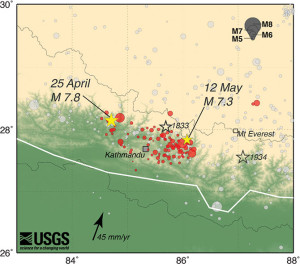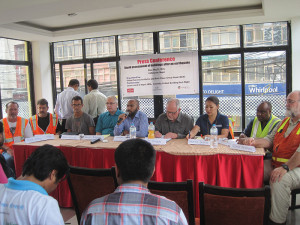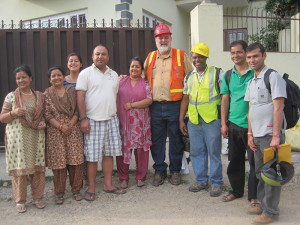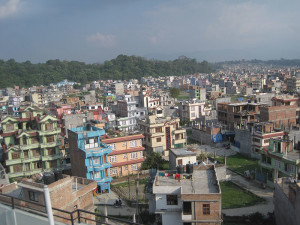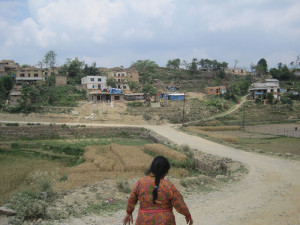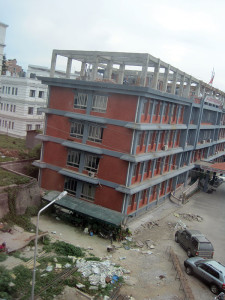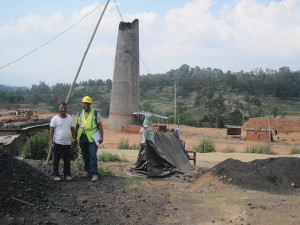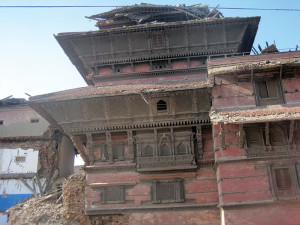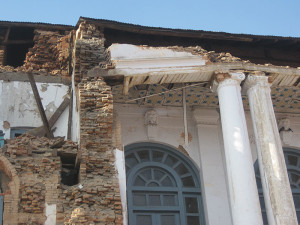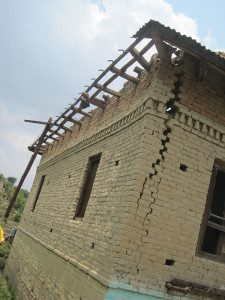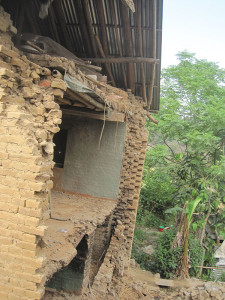Building Assessment and Masonry Construction Performance
Nepal, located within the subduction zone created by the massive Eurasian tectonic plate to the north and the smaller Indian tectonic plate to the south, has eight of the world’s tallest mountains, including Mount Everest and more than 240 peaks over 20,000 feet dotting the northern region of the country. Over the last 180 years, Nepal has encountered nine major earthquakes with two having moment magnitudes (Mw) of 8.0 and 8.4, in 1833 and 1934 respectively. The latest 7.8 Mw earthquake occurred on April 25, 2015, followed by a 7.3 Mw earthquake on May 12, 2015. Both earthquakes had epicenters close to Kathmandu, the country’s capital, as shown in Figure 1.
The earthquakes killed over 9,000 people, injured over 23,000 and damaged over 500,000 structures that included schools, hospitals, public buildings, residences, and UNESCO heritage sites. More than two million people were left homeless not only in the city of Kathmandu, but in the surrounding villages in the greater Kathmandu Valley.
Building Assessment Team
According to data from the Nepal Engineers’ Association (NEA), the country has an estimated 15,000 engineers, with only about 400 of them in structural engineering practice, serving the country of close to 29 million people. About 50% of the country’s structural engineers were working out of the country when the earthquakes occurred. Following the earthquakes, the Government of Nepal (GON) contacted international non-governmental organizations (NGO) requesting assistance in bringing international structural engineers to Nepal to help in the much needed expert evaluation of the safety of the earthquake-damaged structures. There was an urgency in the exercise in order to get the displaced population from tents to safe homes before the heavy monsoon rains arrived, which were on the horizon.
The Global Fairness Initiative (GFI), a Nepal NGO based in Washington D.C., reached out to the International Masonry Institute seeking personnel willing to travel to Nepal for the structural assessment of the building structures. IMI assisted GFI to assemble a team of 13 structural engineers, including the author, selected from various parts of the United States and three from Australia and New Zealand. Many members were from The Masonry Society and the National Council of Structural Engineers Association (NSCEA).
GFI wanted engineers familiar with post disaster assessment to hit the ground running once in Nepal. The selected structural engineers were experts in seismic analysis of building structures and had global experience in post disaster needs assessment. Two teams were formed, with the first one arriving on May 12, 2015 and the other on May 21, 2015. Each team was in Nepal for nine days with exercises ending on May 29, 2015. Figure 2 shows the first team, made up of all American engineers, at a press conference on the building assessments.
Structural Assessment of Building Structures
The primary goals for the assessment of the building structures were to either get people back into undamaged structures or out of unsafe structures. A secondary goal was to provide on-the-job training to the available Nepali engineers on structural assessment of building structures. Through the coordination of GFI and NEA, at least two Nepali engineers were teamed up with each international engineer in order to do the training and equip the Nepali engineers with the knowledge to continue with the assessments once the international engineers left the country. This also made it possible to accomplish more assessments.
The Terms of Reference (TOR) for the international engineers was provided by the Ministry of Urban Development, while the Kathmandu Valley Development Authority provided the list of buildings with high public use for the safety evaluation. The National Society for Earthquake Technology-Nepal (NSET)’s Seismic Vulnerability Evaluation Guideline for Private and Public Buildings, Part II: Post Disaster Damage Assessment was used as a building assessment guide. The procedures in the document and the field forms are similar to those of the United States’ ATC 20 procedures, including the placard postings of Green – Inspected, Yellow – Restricted Use and Red – Unsafe. The document is also adopted by the United Nations Development Program (UNDP). Both rapid and detailed evaluations were conducted as needed. The international team received liability protection from the Nepal government.
By the end of the assessment period, both teams had evaluated about 3,000 structures including education facilities, commercial buildings, hospitals, residences, world heritage sites, shopping malls, high-rise apartments, and other building structures in Kathmandu, Lalitpur, Bhaktapur, Kavre and Sindhupalchok.
An estimated 75,000 people benefited from the building evaluations conducted by the international team. Thousands of people living in tents were able to move back to homes which were determined to suffer no structural damage. Recommendations were also offered to building owners whose structures were identified as structurally unsafe or damaged, either demolition or possible repair procedures. Figure 3 shows a happy family who was living in a tent when they learned from several American and Nepali engineers that they could move back to their three-story building, which had not suffered serious structural damage.
Building Construction
Adobe, brick and reinforced concrete are the main building materials in Nepal. There are approximately 150 brick kilns throughout Nepal, but the quality varies greatly. The country has limited domestic Portland-cement production capabilities. It is heavily dependent upon imports from India. Therefore, newer commercial masonry construction uses cement-based mortars but many buildings still use mud mortar.
Currently, the building code in Nepal is poorly enforced. It includes prescriptive Mandatory Rule of Thumb (MRT) guidelines published by the Department of Urban Development and Building Construction under the Ministry of Physical Planning and Works of the GON. The common Nepal National Building Code (NBC) chapters are:
1) NBC 105: 1994, Seismic Design of Buildings in Nepal.
2) NBC 201: 1994, Mandatory Rules of Thumb Reinforced Concrete Buildings With Masonry Infill.
3) NBC 202: 1994, Mandatory Rules of Thumb Load Bearing Masonry.
4) NBC 205: 1994, Mandatory Rules of Thumb Reinforced Concrete Buildings Without Masonry Infill.
5) NBC 205: 2012, Ready to Use Guideline for Detailing of Low Rise Reinforced Concrete Buildings Without Masonry Infill.
Due to the shortage of Nepali structural engineers in the country, most buildings are constructed by self-taught or on-the-job trained contractors in consultation with home owners. In these cases, the above MRT procedures are used, which are essentially prescriptive techniques. The more modern buildings are engineered. It appears that the majority of the construction uses the MRT guidelines with unregulated variations.
The MRT defines one type of un-engineered building as a reinforced concrete (RC) frame structure with or without masonry infill. The building is limited to three stories, or 36 feet in height, and a plan of 80 feet by 80 feet maximum. Each direction is limited to a maximum of six bays of at most 14 feet width. 4-inch concrete slab panels with a maximum of 145 square feet of area are required to be reinforced by #3 bars at 6-inch center-to-center each way. 9-inch wide by 12-inch deep concrete beams with two or three #4 or #5 bars tension reinforcement, top and bottom, and ¼-inch diameter wire stirrups. 9×9-inch upper level and 10×10-inch lower level columns with 4 – #4 or 4 – #5 bars, respectively, and #3 ties at 5-inch spacing are used. Footing sizes and reinforcements are also given for different columns depending on their location in the buildings (interior, corner, face) for weak, soft, medium and hard soil conditions. The infill bricks used are unreinforced.
As seen in Figure 4, buildings in the urban areas exceed the three story requirement. In the rural areas, buildings are either rubble stone in mud mortar or adobe in mud mortar. Some of the multi-level construction has bamboo floors. The MRT covers rubble stone but not adobe construction.
Where the guidelines of the MRT were followed or where buildings were engineered, there was minimal damage to the infill brick systems as shown in Figure 5.
Performance of Masonry Structures
Use of adobe and brick in Nepal dates back to the 3rd through the 10th centuries when the world heritage royal palaces (Durbar) and temples were built. The majority of the older historic construction, also currently practiced in the villages by the economically marginalized population, are comprised of either unreinforced brick with mud mortar or adobe with mud mortar bearing wall systems. Adobe is currently made using the same ancient back-breaking methods in sites located in the vast valleys. Bricks are fired in large kilns. A single kiln fires up to one million bricks per run. Figure 6 shows a photograph at a brick plant site. The unreinforced brick kiln was also damaged by the earthquake.
The residential and historical floor systems are either a) unreinforced mud or cement plaster over wooden planks and floor joists, or b) mud plaster on bamboo floor systems. The roofs consist of either a) fired clay tiles over wooden planks over wood roof joist with mud mortar, or b) corrugated metal deck over wood joists. The foundation systems consist of rubble stone. Bricks used as infill in the reinforced concrete frame systems were all unreinforced. The bearing wall brick and mud mortar buildings were heavily damaged, as seen in Figure 7.
In URM buildings located mostly in the rural villages, failures were triggered by out-of-plane failure of the exterior walls due to a lack of positive connection of the floors and the walls, as shown in Figure 8. There was also disconnection of interior walls at the corners due to lack of proper connection details.
Conclusions
The building assessment teams accomplished their goals, as thousands of people were able to return to their homes or were given guidance on how to repair homes with minor non-structural damages. The teams also participated in capacity building by teaching the few available Nepali engineers about the principles of earthquake behavior of building structures and associated structural safety assessments, including repair procedures.
Brick and adobe are the materials of choice and the only sustainable construction materials in Nepal, especially in the rural villages located in remote mountainous sites that lack adequate road access. Based on observations from the building assessments after the 2015 earthquakes, the multi-story brick and mud mortar buildings performed very poorly. The brick infills in RC frame buildings performed generally well. The dated historic monuments, palaces and temple structures, most of which are recognized as UNESCO heritage sites, performed poorly.
Recommendations
Nepal is in urgent need of help from the international structural engineering community, both to repair damaged historic structures and to network with the government in developing sound building construction procedures, sustainable national building codes and enforcement procedures. In enhancing the continued use of masonry construction, this may include but is not limited to:
1) Outlaw the use of mud mortar in construction. Develop a cement-based mortar mix that is affordable for poor villagers.
2) Develop guidelines that expand the MRT for rural homes to include provisions on how to build adequate horizontal diaphragms.
3) Develop details for adequately anchoring exterior walls of load bearing structures, including parapets to roof and floor diaphragms for new construction, and repair of existing structures.
4) Urgently educate homeowners, contractors and engineers on ways to build or rebuild earthquake resistance structures through workshops and other media outlets.
5) Develop details and train Nepali professionals on how to repair the massive brick and mud mortar historic structures.
6) Provide recommendations for the implementation of regulatory processes for design-and-construction permitting of new construction and repairs.
7) Implement more engineering training for the design and assessment of masonry structures.
8) Improve the quality of brick manufacturing and develop a quality assurance program for materials.▪

